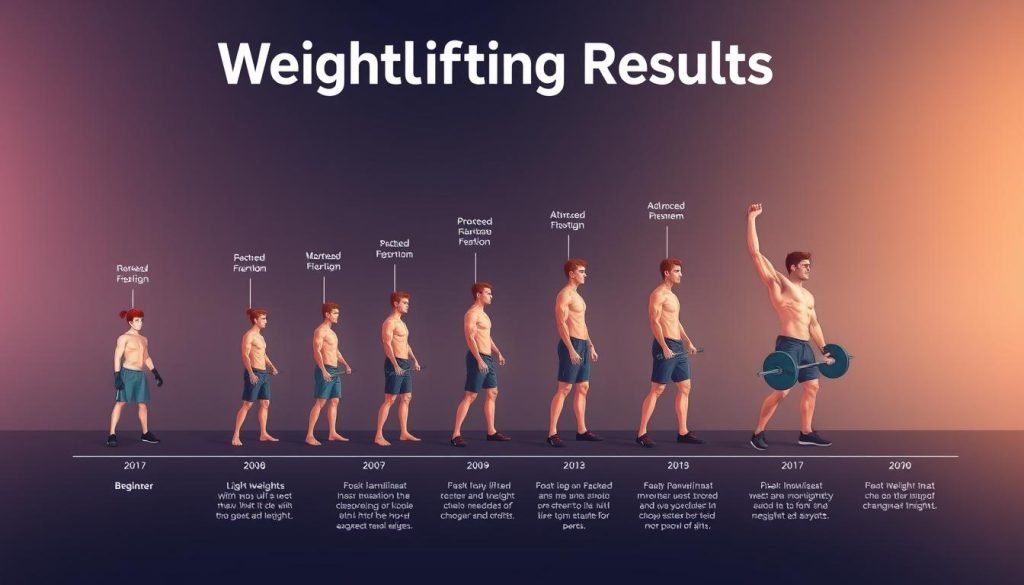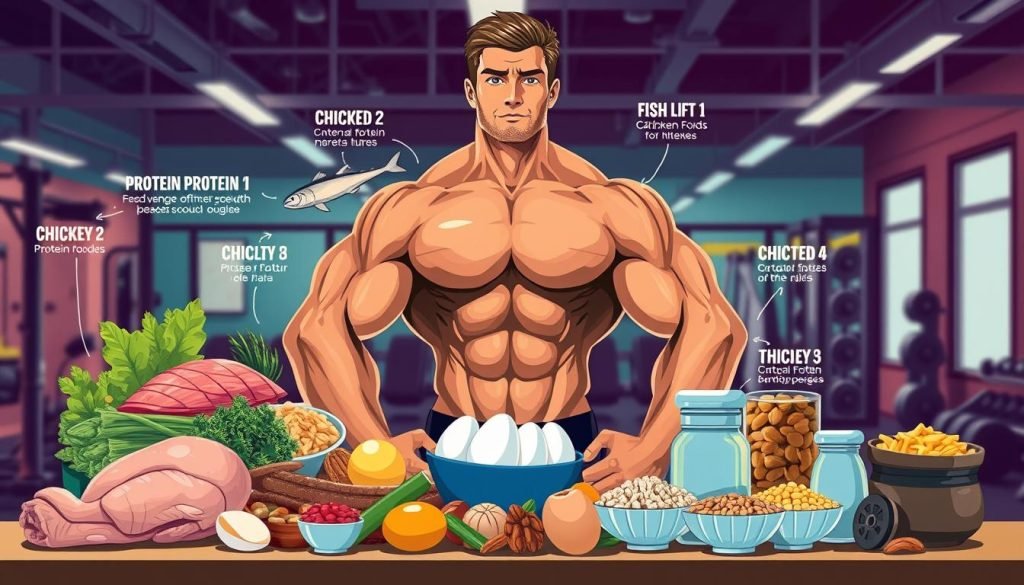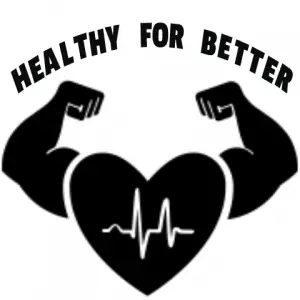Ever looked in the mirror after weeks of weightlifting, wondering when you'll see results? You're not alone. The journey to building muscle is as unique as your fingerprint. Many wonder: how long does it take to see results from lifting weights?
Starting a strength training journey is like planting a garden. You won't see immediate results, but with consistent effort, they will grow. For beginners, seeing muscle growth can be both exciting and frustrating. You might feel stronger before you see any physical changes, which is normal.
The timeframe for seeing strength training results varies for everyone. Some might notice changes in 4-6 weeks, while others might take 8-12 weeks. But don't get discouraged! Your body is changing from the start, even if you can't see it yet.
Building a strong body takes time, just like building Rome. Patience and persistence are key. As you keep lifting, you'll find that the benefits go beyond just looking good. You'll also enjoy better mood, sleep, and energy.
Key Takeaways
- Initial changes may be felt within 4-6 weeks of consistent training
- Visible physical changes typically occur around 8-12 weeks
- Individual factors like genetics and fitness level influence progress
- Strength gains can be noticed before visible muscle changes
- Long-term commitment is crucial for significant muscle growth
- Benefits extend beyond physical appearance to overall well-being
Understanding Weight Training Results Timeline
Starting a weight training journey makes you wonder when you'll see results. The time it takes to notice gains varies for everyone. Let's look at what affects your progress on a muscular hypertrophy schedule.
Neural Adaptations in Early Stages
In the first four to six weeks, your body makes neural changes. These improvements help your muscles work better, leading to strength gains. This early phase is key for setting the stage for future growth.
Role of Genetics and Individual Factors
Genetics are a big factor in how fast you see results. Your age, health, and stress levels also play a part. Some people might see changes in 8 weeks, while others might take up to 12 weeks.
Importance of Baseline Fitness Level
Your starting fitness level affects how fast you improve. Beginners often see quick gains, known as “newbie gains.” These gains can lead to big increases in muscle and strength in the first 6 to 12 months. Those who've been away from fitness might see faster progress in the first month.
“Results from working out can start showing with initial changes in the first four to six weeks, with longer-term changes taking around eight to 12 weeks.”
Consistency is crucial when following a muscular hypertrophy schedule. Stay committed, focus on proper form, and be patient. With time and effort, you'll see noticeable gains from weight training.
How Long to See Results From Lifting Weights
Weightlifting results vary from person to person. Your bulking up duration depends on genetics, diet, and workout intensity. Here's a breakdown of when you might see results from lifting heavier.
Initial Changes (Weeks 1-4)
In the first month, you'll notice better strength and endurance. Your body quickly adapts, leading to stronger muscle activation. You might not see visible changes yet, but you'll feel stronger and more energized.
Noticeable Changes (Months 2-3)
This is when things get exciting! Your muscles start to look fuller and more defined. You'll lift heavier and see faster results in strength gains. Research shows that consistent training for 2-3 months leads to significant increases in muscle size and strength.

Long-Term Progress (6+ Months)
After six months of dedicated training, you'll see substantial muscle growth. Your physique will be noticeably different, with well-developed muscles. At this stage, focus shifts to maintaining gains and refining your workout routine to continue making progress.
| Timeline | Changes | Focus |
|---|---|---|
| Weeks 1-4 | Strength increase, better endurance | Consistency, form improvement |
| Months 2-3 | Visible muscle definition, significant strength gains | Progressive overload, nutrition |
| 6+ Months | Substantial muscle growth, refined physique | Maintenance, routine optimization |
Remember, consistency is key. Stick to your routine, gradually increase weights, and fuel your body properly to maximize your results. With patience and dedication, you'll achieve your fitness goals!
Factors Affecting Muscle Growth Progress
Muscle growth depends on several factors. These factors affect how quickly you see results from strength training. Knowing these can help you plan better and get the most from your workouts.
How often you train is very important. Experts say you should train each muscle group at least twice a week. This keeps the muscles growing and recovering well.
What you eat is also crucial. You need enough protein to help your muscles repair and grow. Without the right food, even hard workouts won't help much.
Don't forget about rest and recovery. Try to sleep 7-9 hours each night. This helps your muscles recover and grow better.
Remember, consistency is key. Sustainable muscle growth requires dedication over an extended period, often beyond six months.
Age and hormones also play a part. Younger people might see results faster because of more hormones. But, anyone can grow muscle with regular workouts, no matter their age.
| Time Frame | Expected Progress |
|---|---|
| 1-4 weeks | Initial strength gains (neural adaptations) |
| 8-12 weeks | Noticeable muscle growth (hypertrophy) |
| 4-6 months | Solid foundation of muscle |
| 6+ months | Significant muscle development and refinement |
By keeping these factors in mind and sticking to regular workouts, you can improve your strength training results. This will help you reach your fitness goals more effectively.
Building Strength vs. Visible Results
Many people wonder how long it takes to see results from weight training. The truth is, you might see strength gains before you notice muscle changes. Let's look at how long it takes for different fitness progress.
Strength Gains Timeline
Noticeable strength gains from weight training start early. A 2018 review found that you can see strength improvements in 8 to 12 weeks. Some studies show results in just 2 weeks.
This quick progress is because your nervous system gets better at using your muscles. It learns to activate them more efficiently.
Muscle Definition Development
While strength increases fast, muscle changes take longer. A University of Wisconsin study in 2004 found little difference in appearance after six weeks. But, significant muscle size changes usually show up after 2-3 months.
Body Composition Changes
Changes in body composition, like more muscle and less fat, are key to visible results. These changes usually show up after 4-6 months of training. If you want to grow muscle and look good, you'll need to train for more than six months.
“Sustainable weight loss from regular workouts typically occurs at a rate of one to two pounds per week after two to three months.”
Remember, everyone progresses at their own pace. Sticking to your workout and nutrition plan is crucial. It helps you reach your fitness goals, whether it's strength or muscle growth.
Nutrition's Impact on Weight Training Results
Proper nutrition is key to getting the most from weight training. The right diet boosts muscle growth and strength. It's as important as regular workouts.
Protein Requirements for Muscle Growth
Protein is vital for muscle repair and growth. The American College of Sports Medicine suggests 1.2 to 1.7 grams of protein per kilogram of body weight. For a 150-pound person, that's 95 to 136 grams of protein a day.

Caloric Needs for Building Muscle
To build muscle, you need to eat more calories than you burn. Aim for a 300-500 calorie surplus above your maintenance level. This extra energy helps muscles grow and recover.
Importance of Meal Timing
When you eat can affect muscle growth and recovery. Eating protein before and after workouts boosts muscle synthesis. Include protein, carbs, and healthy fats in every meal for balanced nutrition.
| Meal Timing | Recommended Foods | Benefits |
|---|---|---|
| Pre-workout | Greek yogurt, banana, whole grain toast | Energy for workout, prevent muscle breakdown |
| Post-workout | Chicken breast, sweet potato, broccoli | Muscle recovery, replenish glycogen stores |
| Throughout the day | Eggs, lean beef, salmon, beans, cottage cheese | Sustained protein intake, muscle maintenance |
Muscle-building takes time and effort. It needs dedication to both nutrition and workouts. Stay away from alcohol and processed snacks to get the best results from weight training.
Recovery and Rest Period Requirements
To lift heavier and see faster results, proper recovery is crucial. The strength training results timeframe depends greatly on how well you allow your body to recuperate. Rest days are not just breaks; they're an essential part of your fitness journey.
Most lifters find that 2-4 training sessions per week provide ample recovery time. This schedule allows for 48-72 hours between workouts, which is ideal for muscle repair and growth. Remember, as you age, you might need more recovery time between sessions.
Rest intervals during workouts are equally important:
- For muscle growth: 30-90 seconds between sets
- For strength gains: 2-5 minutes between sets
- For endurance: Less than 2 minutes between sets
On rest days, aim for at least 4,000 steps to promote blood flow and recovery. Light activities like stretching or meditation can also enhance your recovery process. Avoid overly active tasks to ensure proper rest.
| Goal | Rest Between Sets | Weekly Training Sessions |
|---|---|---|
| Muscle Growth | 30-90 seconds | 3-4 |
| Strength Gains | 2-5 minutes | 2-3 |
| Endurance | <2 minutes | 3-5 |
Remember, rest is when your muscles grow. By prioritizing recovery, you'll optimize your strength training results timeframe and be able to lift heavier and see faster results in the long run.
Measuring Progress Beyond the Mirror
Tracking your weightlifting progress is more than just looking in the mirror. Using smart strategies, you can see gains from weight training, even when they're not obvious yet.
Tracking Strength Gains
Keep a workout log to track your lifts. One lifter saw big gains over time:
- Squats: 115 lbs to 238 lbs
- Bench press: 100 lbs to 155 lbs
- Deadlift: 120 lbs to 250 lbs
These numbers show how strength can really improve with regular training. Using microplates for small weight increases helps you progress steadily.
Body Measurements and Metrics
Take weekly measurements of nine body areas to track changes. This method helps you see progress in specific parts of your body. Remember, a waist-to-hip ratio of 0.8 or lower is linked to better health outcomes.
Progress Photos Documentation
Monthly photos are great for visual motivation. They show changes that might be hard to notice day-to-day. It's important to have consistent lighting and poses for accurate comparisons.
Don't forget to track workout duration. As weights get heavier, workouts often get longer. One lifter's sessions went from 25 minutes to 40-50 minutes as they got stronger.
Regular check-ins with a doctor can help you set realistic health goals. Some people even use continuous glucose monitors to fine-tune their diet and exercise for better results. By using these methods, you'll have a clear picture of your progress beyond just looks.
Common Plateaus and How to Overcome Them
Hitting a plateau in weightlifting is normal. After six months of regular workouts, progress might slow down. This is because your body gets used to your routine. Let's look at how to spot and beat these plateaus.
Identifying Progress Stagnation
You're likely in a plateau if workouts feel too easy. If you're not getting stronger or losing muscle tone, it's a sign. Also, if your heart rate doesn't change during exercises or you feel unmotivated, it's time to adjust.
Progressive Overload Techniques
To get past plateaus, use progressive overload. This means making your workouts harder. Here are some ways to do it:
- Increase weight
- Add more reps or sets
- Decrease rest time between sets
- Improve form and range of motion
Program Modification Strategies
Change your routine to challenge your muscles in new ways. Try these:
| Strategy | Description | Benefit |
|---|---|---|
| Exercise Variation | Switch to new exercises targeting the same muscle groups | Stimulates different muscle fibers |
| Rep Range Changes | Alternate between high and low rep ranges | Promotes both strength and endurance |
| Rest-Pause Sets | Take brief pauses during a set to extend it | Increases time under tension |
| Periodization | Cycle through different training phases | Prevents adaptation and burnout |
Be patient and consistent to overcome plateaus. Use these strategies and keep up with regular workouts. Also, check your nutrition and recovery, as they're key to success.
Conclusion
Wondering how long to see results from lifting weights? The timeline for muscle growth varies. But with dedication, you can see changes in 8-12 weeks. Amanda Hughes, a seasoned fitness trainer, says beginners often see faster results than seasoned lifters.
Consistency is crucial. Aim for 3-5 workouts a week to start your transformation.
Your journey doesn't stop at 3 months. Months 4-6 bring steady gains in strength and definition. If you hit a plateau around months 7-9, don't worry. It's a normal part of the process.
Mix up your routine with high-intensity exercises or try new workout classes. This keeps things fresh and challenging.
Progress isn't just about how you look. Track your journey with before-and-after photos, strength measurements, and a fitness journal. Join a supportive community like Lagree or find a workout buddy to boost motivation.
For sustained success beyond the first year, reassess your goals regularly. Don't hesitate to seek guidance from fitness pros. Your weight lifting results show your hard work. Enjoy the journey!
FAQ
How long does it typically take to see results from lifting weights?
You might feel changes in 4-6 weeks. But, you'll see real changes in 8-12 weeks if you keep training. It depends on your genetics, fitness level, and goals.
What are the first changes I might notice when starting a weightlifting routine?
At first, you might feel more energetic and sleep better. Your muscles will get stronger and more durable. But, you won't see the changes right away.
How long does it take to see significant muscle growth?
You'll see big muscle growth after 6+ months of working out. But, you might notice fuller muscles in 2-3 months.
What factors affect how quickly I'll see results from lifting weights?
Many things can change how fast you see results. This includes how often and hard you work out, what you eat, how well you rest, and your age and health.
How much protein should I consume for optimal muscle growth?
Eat 1.6 to 2.2 grams of protein for every kilogram of your weight each day. Also, eat more calories than you burn to build muscle.
How often should I rest between workouts?
Rest for 48-72 hours between workouts on the same muscle group. Also, sleep 7-9 hours a night to recover and stay balanced.
How can I track my progress beyond just looking in the mirror?
Track your progress by recording your workouts, taking body measurements, and taking photos. Also, check your body fat percentage and weight.
What should I do if I hit a plateau in my weightlifting progress?
To get past a plateau, try lifting more, changing your workout, or trying new methods. Also, check your diet and rest.
Will lifting heavier weights help me see results faster?
Lifting heavier can help you get stronger faster. But, it's not the only way to see results. A balanced approach is best for muscle growth and visible changes.
How does my starting fitness level affect how quickly I'll see results?
Your fitness level at the start affects how fast you improve. Beginners see quick gains. But, more experienced people can still get great results with the right training and diet.
Source Links
- https://www.womenshealthmag.com/fitness/a36620732/how-long-does-it-take-to-see-workout-results/
- https://www.polar.com/blog/how-long-to-see-results-from-working-out/?srsltid=AfmBOoploYwVwVu1HjNBCQb5Otky137raCFmtaECfbr-ChnatdRFU5Q2
- https://www.livestrong.com/article/333343-how-long-before-seeing-results-from-lifting-weights/
- https://www.polar.com/blog/how-long-to-see-results-from-working-out/?srsltid=AfmBOooAcpAVODpgeQ215tmeqSV-rL16cR4TtS-07x2Eq1s0qqxiO0wL
- https://www.health.com/fitness/scale-weight-loss-progress
- https://www.polar.com/blog/how-long-to-see-results-from-working-out/?srsltid=AfmBOoqEOpefeMIUd7OmiCU-uRt2kF-M6e0q6oZK4029PhOPlTVpIN9f
- https://www.artofmanliness.com/health-fitness/fitness/how-long-does-it-take-to-put-on-muscle/
- https://www.hitonefitness.com/how-long-to-see-results-from-lifting-weights/
- https://www.polar.com/blog/how-long-to-see-results-from-working-out/?srsltid=AfmBOooxigp_Utt3RsYopT0I2cxP24eGcatWEPtBgOBBtXPHUere73ah
- https://www.cnet.com/health/fitness/how-long-does-it-really-take-to-build-muscle/
- https://www.polar.com/blog/how-long-to-see-results-from-working-out/?srsltid=AfmBOoryfsJ0QqsNdzag99yUIEeptKbiI9vd1ee4BVWhL2YoHm36gOUw
- https://www.healthline.com/health/exercise-fitness/hypertrophy-vs-strength
- https://www.menshealth.com/fitness/a61927639/how-long-to-see-fitness-results/
- https://www.mayoclinic.org/healthy-lifestyle/fitness/in-depth/strength-training/art-20046670
- https://www.issaonline.com/blog/post/eat-to-gain-musclethe-role-food-plays-in-strength-training
- https://www.menshealth.com/fitness/a45126115/how-many-rest-days-a-week/
- https://shop.bodybuilding.com/blogs/recovery/the-science-of-muscle-recovery-how-long-should-you-rest-between-workouts?srsltid=AfmBOoowIeOHJdFxPYbPIbEj_1KqRKGhgDtFJr_9b4AZWEem0ZlpU2Lp
- https://www.healthline.com/health/fitness/rest-between-sets
- https://rippedbody.com/diet-progress-tracking/
- https://stevepavlina.com/blog/2018/03/results-from-5-months-of-strength-training/
- https://www.nutrisense.io/blog/how-to-track-your-fitness?srsltid=AfmBOoqcmOcy694VYSA3QG4fKwUcfRQaTPQSMZkDiISUF0E8wiUjn1mf
- https://www.verywellfit.com/six-tips-to-break-through-strength-training-plateaus-3120744
- https://www.healthline.com/nutrition/workout-plateau
- https://www.independent.co.uk/life-style/health-and-families/workout-weight-loss-results-time-b2071240.html
- https://www.pilatesplusla.co/blog/fitness-progress
Recent Posts
It's important to evaluate whether Beachbody On Demand continues to meet your fitness needs as we enter 2025. With a range of workout programs and nutrition plans, the platform claims to cater to...
Just like having a personal trainer at your fingertips, Beachbody On Demand offers you an extensive library of on-demand workout programs accessible anytime, anywhere. This service allows you to...

